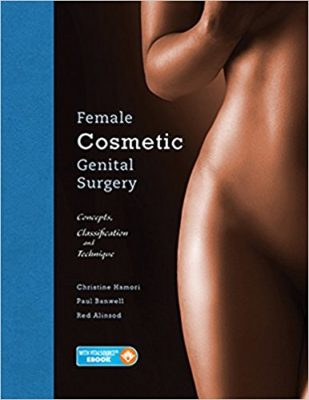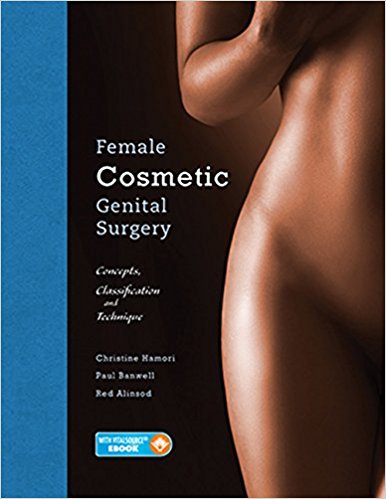 Editors: Christine Hamori, MD; Paul Banwell, MBBS; and Red Alinsod, MD
Editors: Christine Hamori, MD; Paul Banwell, MBBS; and Red Alinsod, MD
Publisher: Thieme – 282 pages
Book Review by: Nano Khilnani
Nearly 9,000 patients underwent in 2015, the procedure of labiasplasty, part of a group of female cosmetic genital surgeries. This number is based on statistics from the American Society for Aesthetic Plastic Surgery, It represents a 16 percent increase from 2014, and it is for labiaplasties alone, and does not include related procedures such as vaginal tightening. For better a perspective, read The Rise in Labiaplasty: Social Influences, on page 25 in chapter 2.
The reasons for such surgeries are physical as well as psychosocial, the editors write. They point out that studies show the effectiveness of genital rejuvenation in meeting physical and psychosocial needs of patients seeking such treatment.
Fifteen specialists (including the three editors named above) in aesthetic plastic and reconstructive surgery, cosmetic cellular medicine, dermatology, gynecology, and obstetrics, and related fields, from all over the United States and six other countries – Australia, Brazil, Colombia, France, Russia, and the United Kingdom – authored the 17 chapters of this book.
We list the titles of the chapters below, organized around three Parts, to give you an overview of the contents of this book:
- Part I. Introduction
- Anatomy and Classification of the Female Genitalia: Implications for Surgical Management
- Psychological Issues and Social Mores in Female Genital Aesthetic Surgery: What Is Normal?
- Informed Consent and Liability in Cosmetic Genital Surgery
- Part II. Techniques
- Labia Reduction: Surgical Wedge Technique
- Labia Minora Reduction Surgery: Curved Linear Resection
- Labia Majora Reduction Surgery: Majoraplasty
- Clitoral Hood Reduction Techniques
- Augmentation of the Labia Majora With Fat Grafting
- Augmentation of the Labia Majora With Fillers
- Complications of Female Cosmetic Genital Surgery
- Perineoplasty and Vaginoplasty
- Hymenoplasty
- Auxiliary Procedures
- Part III, Advances
- Future Avenues and Advances
- O-Shot
- Transcutaneous Temperature-Controlled Radiofrequency for Vulvovaginal Rejuvenation
- Fractional Erbium Laser for Vaginal Rejuvenation
In addition to the contents in this print volume, you as the purchaser can also access this entire book and additional related content available online. Videos of 12 different procedures are also available. Do the following to access the content online:
- Create an account on Thieme’s e-book store: ebookstore.Thieme.com/register
- Click the My E-books link and select Redeem Access Code
- Enter the access code found underneath the gray film on the slip of paper found on the first page of the book. Scratch off the film to retrieve the access code
- You can now start reading the book online and make notes as well.
In Part I, chapter 2 entitled Psychological Issues and Social Mores in Female Genital Aesthetic Surgery: What Is Normal ? is an interesting chapter to read, and I believe, an important one when one is seeking an answer to the question of why women want to have modifications for aesthetic reasons. The answer can be found quickly when you jump to the Conclusion wherein the chapter authors Kharen Ichino and Jennifer Walden write:
“Whether there is a norm for external female genitalia is in question, but many patients have psychological improvements after female genital aesthetic surgery. Because of the range of measurements for each part of the genitalia, determining specific, normal measurements is difficult. This variability and constant access to its imagery in contemporary society explain why aesthetic surgery of the female genitalia is rising in popularity.”
In Part II which is focused on surgical techniques, many known and familiar procedures are presented and discussed. That makes this book quite extensive in coverage of a range of surgical procedures as well as approaches and techniques.
An interesting portion to read in Part II is chapter 8: Augmentation of the Labia Majora With Fat Grafting The chapter authors Lina Triana and Paul E. Banwell write that the main reasons (“indications,” in medical terminology) for women to augment (make fatter or larger) their labia majora are: hypoplasia, loose skin, or both. Hypoplasia is underdevelopment or incomplete development of an organ, body part, or section.
Drs. Triana and Banwell write: “If the labia are very ‘baggy’ with significant excess skin, then excisional labia majora reduction should also be considered. Treatment options include autologous fat grafting and the use of dermal fillers.”
They answer the question: “Why perform augmentation of the Labia Majora?” by stating in essence that in today’s society, men and women desire the current vogue of minimal pubic hair, smooth and prominent labia that provide a more youthful appearance of concealed labia minora and full, smooth labia majora.
In Part III, the focus is on recent advances in the field and exciting possibilities in the future. Chapter 16, Transcutaneous Temperature-Controlled Radiofrequency for Vulvovaginal Rejuvenation, provides some relatively newer information.
The top of the chapter lists in the Key Points section such developments as temperature controlled radiofrequency (RF) enabling tightening of loose skin and tissue; new collagen formation and neo-angiogenesis, resulting in improved skin tone and sensitivity; improved blood flow; alleviation of orgasmic dysfunction; and tightening of loose skin and tissue.
This is a great book on a subject that is sparsely covered in medical literature, so that factor alone makes it valuable. But it is also a one-of-a-kind work that is authoritative, well-planned and expertly written. We highly recommend it.
Editors:
Christine Hamori, MD, FACS is a Board-Certified Plastic Surgeon and is Founder and Director of Cosmetic Surgery and Skin Spa in Boston, Massachusetts.
Paul Bandwell, MBBS, FRCS (Eng.), FRCS (Plast) is Consultant Plastic, Reconstructive and Aesthetic Surgeon at The Banwell Clinic in McIndoe Center in East Grinstead, West Sussex, in the United Kingdom.
Red Alinsod, MD, FACOG, FACS is Director of the South Coast Urogynecology, and Alinsod Institute for Aesthetic Vulvovaginal Surgery in Laguna Beach, California.







